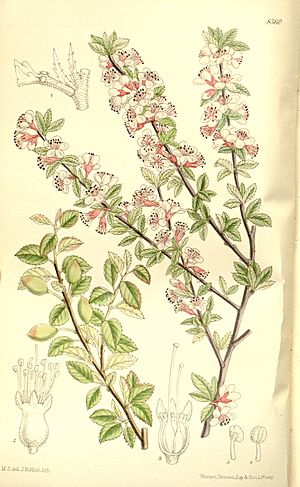Small-fruited cherry facts for kids
Quick facts for kids Small-fruited cherry |
|
|---|---|
 |
|
| Scientific classification | |
| Genus: |
Prunus
|
| Species: |
microcarpa
|
| Synonyms | |
|
|
The Small-fruited Cherry, known scientifically as Prunus microcarpa, is a type of cherry tree or bush. It grows naturally in Western Asia and the Caucasus region.
What Does It Look Like?
The Small-fruited Cherry is a bushy plant. It loses its leaves in the fall, just like many trees. Its branches are quite stiff. The leaves are smooth and shaped like an oval or an egg.
In April, this plant grows pretty flowers. They are usually white or light pink. Each flower is about 1 centimeter wide. They can grow alone or in pairs.
The plant also produces small fruits. They are about 1 centimeter long and egg-shaped. When they are ripe, their color changes. They can be yellow, orange, red, or even black.
How People Use It
People have found interesting uses for the Small-fruited Cherry. For example, the fruit can be used to make a dark grey or green dye. You can also get a green dye from the leaves of the plant.
Important Safety Note
Some plants in the Prunus family, including cherries, contain natural chemicals. These chemicals can break down to produce a tiny amount of a substance called hydrogen cyanide. This substance is what gives almonds their special flavor.
It is mostly found in the leaves and seeds. Usually, the amount is too small to cause any harm. However, it is always important to be careful. Never eat any wild seeds or fruits that taste very bitter. It is best to only eat plants that you know are safe. Always check with an adult before trying any wild plants.
Growing Your Own
The Small-fruited Cherry needs a lot of sunlight to grow well. It prefers dry conditions. The best soil for it is one that drains water well but also holds some moisture.
If the shallow roots of the plant get damaged, new shoots might grow up from the ground. These are called suckers.
Like many plants, the Small-fruited Cherry can be affected by pests. One common problem for Prunus plants is a type of fungus called honey fungus.
If you want to grow this plant from a seed, it needs a special treatment. The seed must be kept cold for about two to three months. This helps it get ready to sprout.

